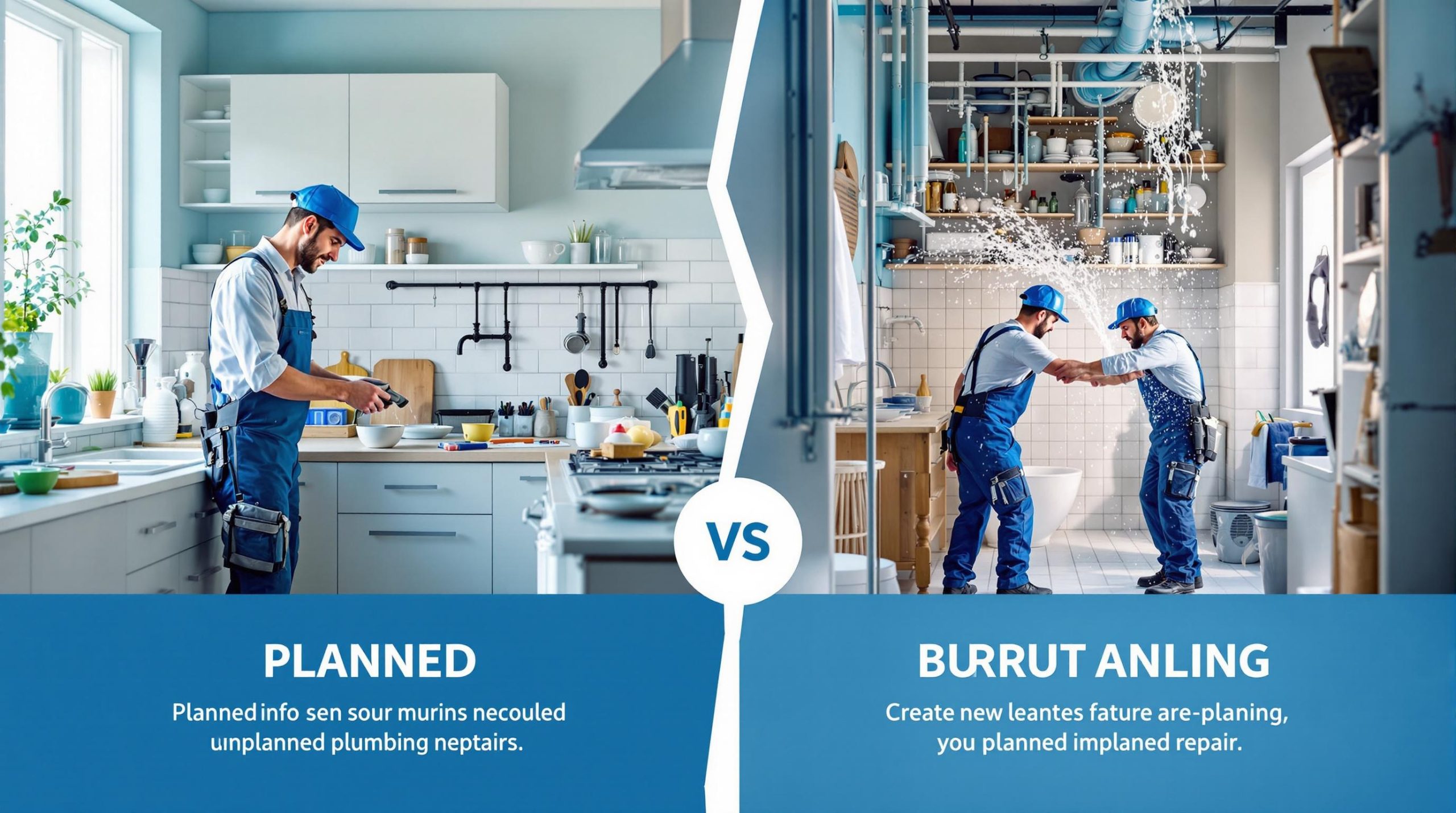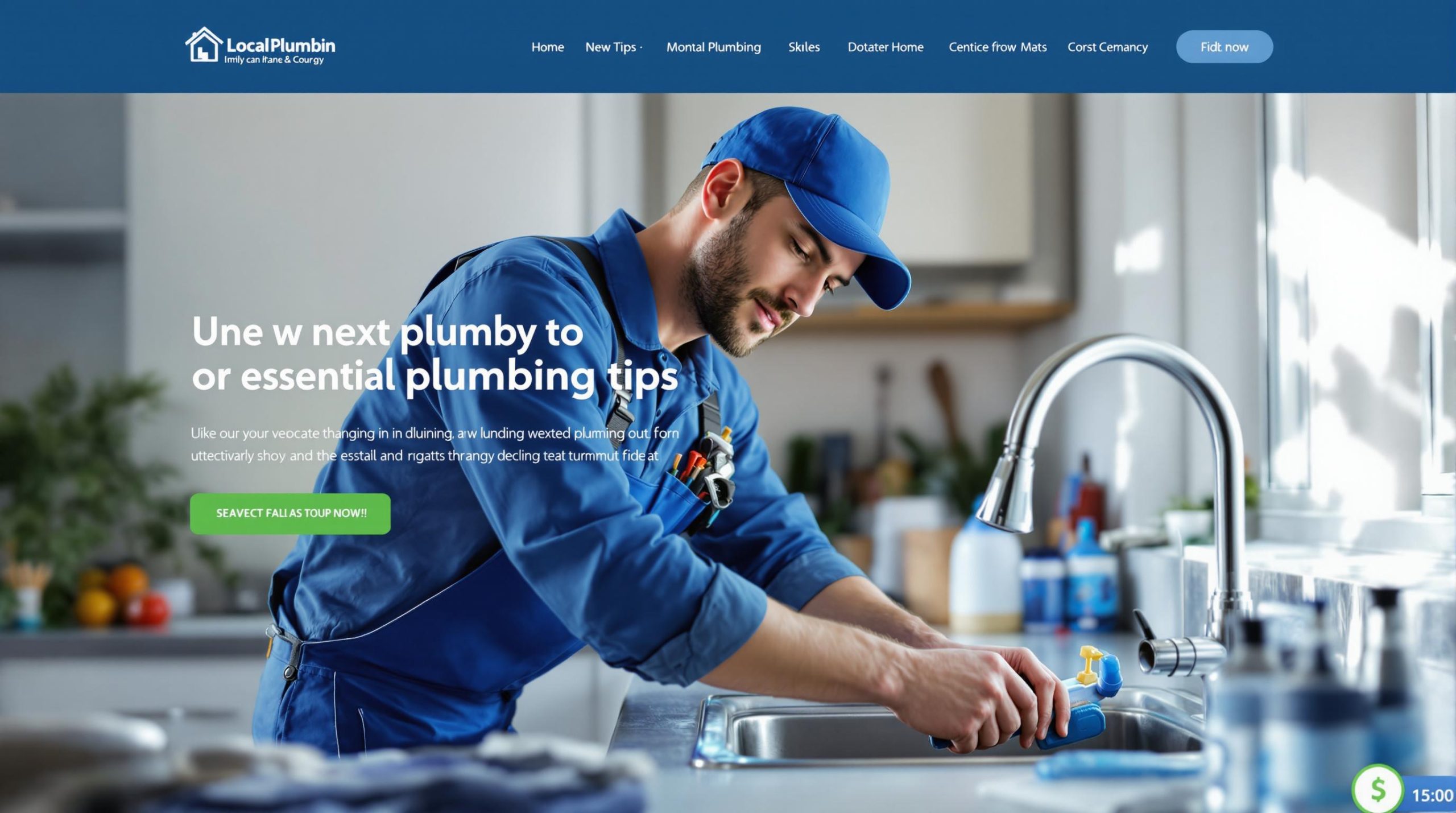Did you know unplanned plumbing repairs can cost 3–5× more than planned maintenance? Here’s why staying proactive with your plumbing system saves money, time, and stress:
- Planned Maintenance: Regular inspections, cleaning, and upkeep prevent costly issues. Costs are predictable, downtime is minimal, and equipment lasts 15–25% longer.
- Unplanned Repairs: Emergencies like burst pipes or sewer backups come with unpredictable downtime and steep costs – up to $450/hour for after-hours services.
Quick Comparison
| Aspect | Planned Repairs | Unplanned Repairs |
|---|---|---|
| Cost Impact | Predictable, lower costs | 3–5× higher costs |
| Downtime | 30–50% less downtime | Extended, unpredictable |
| Equipment Lifespan | 15–25% longer | Shortened |
Key Takeaway
Investing in scheduled maintenance avoids emergencies, extends your plumbing system’s life, and protects your budget.
Plumbing Costs: Regular vs. Emergency Hours Explained!
1. Scheduled Maintenance and Repairs
Scheduled maintenance focuses on addressing potential problems before they become costly. For example, even a small leak can waste gallons of water daily, while major plumbing repairs might set you back thousands.
Here’s what a typical maintenance plan might include:
| Task | Frequency | Average Cost |
|---|---|---|
| Professional Inspection | Annually | $336 |
| Sewer Line Cleaning | Every 1-2 years | $175-$475 |
| Water Heater Flush | Every 6 months | Part of service plan |
| Pipe Assessment | Every 2-3 years | Included in inspection |
If your property has mature trees, consider scheduling inspections twice a year. Tree roots can damage sewer lines, and repairing them could cost as much as $6,300.
Keep an eye on your water pressure. It should stay between 45 and 65 PSI to avoid unnecessary strain on your pipes. Regular monitoring can help catch problems early.
"When it comes to your home’s plumbing, an ounce of prevention is worth lots of money saved on costly repairs and big water bills." – Amica Insurance
Professional service plans, like the ASAP Care Plan, make maintenance easier. For $14 per month (with a 12-month minimum commitment), you get regular inspections, maintenance services, and reduced hourly rates. For reference, commercial plumbers charge about $100 per hour, while residential plumbers average $80 per hour.
Here’s a snapshot of repair costs:
- Small plumbing repairs: $125-$350
- Larger planned repairs: $500-$800
- Emergency pipe burst repairs: $400-$2,000
Modern tools and predictive maintenance techniques can even help anticipate pipe failures before they occur. For instance, a slow toilet leak can waste up to 30 gallons of water every day.
With prevention covered, let’s dive into what happens when emergency repairs are unavoidable.
sbb-itb-c287090
2. Emergency Repairs
When it comes to emergency plumbing repairs, quick action is crucial – and it often comes with a hefty price tag. Expect to pay $120–$300 per hour on weekdays and $225–$450+ per hour on holidays. On top of that, there’s usually a trip fee ranging from $100 to $300.
Here’s a breakdown of typical emergency repair costs:
| Emergency Issue | Cost Range |
|---|---|
| Clogged Drain | $300 to $800 |
| Burst Pipe | $500 to $1,500 |
| Sewer Backup | $500 to $3,800 |
| Water Heater Failure | $500 to $1,200 |
Even minor issues, like a running toilet or a small faucet leak, can waste up to 200 gallons of water daily, so addressing problems quickly is essential.
What To Do During a Plumbing Emergency
Act fast when an emergency strikes:
- Burst Pipes: Shut off the main water valve immediately.
- Overflowing Toilets: Turn off the water supply valve located behind the toilet.
- Gas Leaks: Evacuate the area and contact 911 or your gas company.
"Many folks do not fully realize the high cost of cleaning up from water damage and the importance of taking immediate action when a sudden water leak or sewer issue occurs."
– David Balkan, CEO of Balkan Sewer And Water Main
Delays can lead to major expenses. In fact, unplanned repairs often cost three to five times more than routine maintenance.
How To Prevent Plumbing Emergencies
A few proactive steps can help you avoid costly emergencies:
- Install water sensor alarms in areas prone to leaks.
- Use WiFi-connected sewer alarms to detect backups early.
- Regularly inspect washing machine hoses for wear and tear.
- Add a water softener if you live in a hard water area.
For commercial kitchens, proper grease trap maintenance and staff training on waste disposal are essential to avoid plumbing disasters.
Emergency plumbers in Ipswich are typically well-prepared, arriving with fully stocked vehicles to handle most issues on-site. While waiting for help, focus on minimizing damage by moving valuables and containing leaks. These tips can help you manage emergencies effectively while preparing for repair solutions.
Comparing Repair Options
Let’s break down the key factors when choosing between scheduled maintenance and emergency plumbing repairs.
Cost Comparison
Emergency plumbing services come at a premium. Rates typically increase by 1.5× on weekday evenings, 2× on weekends, and 3× on holidays. The table below highlights the cost differences for residential and commercial plumbing:
| Service Type | Regular Rate | Emergency Rate |
|---|---|---|
| Residential Plumbing | $80 per hour | Around $170 per hour |
| Commercial Plumbing | $100 per hour | $150–$300 per hour |
Time and Convenience Factors
Planned maintenance offers clear advantages in terms of timing and convenience. A study of 100 factories revealed that scheduling maintenance reduced downtime by 30–50% compared to emergency repairs. This principle applies to plumbing too – routine checks can be arranged during off-peak hours, minimizing disruptions and ensuring smoother operations.
Long-term Outcomes
Proactive maintenance pays off in the long run by safeguarding your plumbing system and your property. Here’s how:
- Extends System Lifespan: Regular inspections help pipes and fixtures last longer.
- Saves Money: Catching small issues early avoids expensive emergency repairs.
- Protects Your Property: Routine checks reduce the chances of structural damage caused by leaks or failures.
Decision Impact Analysis
Fixing a small leak during scheduled maintenance might cost $125–$250. Ignoring it could lead to emergency repairs ranging from $500–$1,500, not to mention the potential for secondary damage.
For commercial properties, the stakes are even higher. Proactive maintenance isn’t just a good idea – it’s a smart investment for property managers and business owners.
Conclusion
The contrast between planned and unplanned repairs highlights the importance of staying on top of maintenance in Ipswich. Regular upkeep can extend equipment life by 15–25% and cut system downtime by as much as 50%, offering both operational and financial gains.
To avoid plumbing emergencies, property owners can take these steps:
-
Schedule Regular Inspections
Annual check-ups help catch problems early, saving money on emergency fixes and keeping systems running smoothly. -
Use Protective Measures
Install mesh drain screens and insulate pipes to tackle common issues like clogs and freezing. -
Keep an Eye on Water Pressure
High water pressure can damage pipes. Pressure-reducing valves help maintain safe levels and prolong system life.
These preventive measures are cost-effective. A scheduled maintenance visit typically costs $80–$200, while emergency repairs can run $150–$400 per hour, not including after-hours charges.
"With a plumbing maintenance plan, you can rest easy knowing that you are maintaining your plumbing at peak condition." – Benjamin Franklin Plumbing
DIY fixes often fall short, with 70% of attempts ending in failure. Professional maintenance not only protects your plumbing but also helps you avoid costly emergencies, which could lead to water damage claims averaging $11,098.



